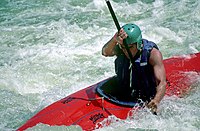
Photo from wikipedia
Aim of the study : Public access to automated external defibrillators (AEDs) plays a key role in increasing survival outcomes for patients with out-of-hospital cardiac arrest. Based on the concept… Click to show full abstract
Aim of the study : Public access to automated external defibrillators (AEDs) plays a key role in increasing survival outcomes for patients with out-of-hospital cardiac arrest. Based on the concept of maximizing "rescue benefit" of AEDs, we aimed to develop strategies for optimal deployment of AEDs for long and narrow spaces. Methods : We classified the effective coverage of an AED in hot, warm, and cold zones. The AEDs were categorized, according to their accessibility, as fixed, summonable, or patrolling types. The overall rescue benefit of the AEDs were evaluated by the weighted size of their collective hot zones. The optimal strategies for the deployment of AEDs were derived mathematically and numerically verified by computer programs. Results : To maximize the overall rescue benefit of the AEDs, the AEDs should avoid overlapping with each others coverage as much as possible. Specific rules for optimally deploying one, two, or multiple AEDs, and various types of AEDs are summarized and presented. Conclusion : A methodology for assessing the rescue benefit of deployed AEDs was proposed, and deployment strategies for maximizing the rescue benefit of AEDs along a long, narrow, corridor-like, finite space were derived. The strategies are simple and readily implementable. Our methodology can be easily generalized to search for optimal deployment of AEDs in planar areas or three-dimensional spaces.
Journal Title: PLOS ONE
Year Published: 2022
Link to full text (if available)
Share on Social Media: Sign Up to like & get
recommendations!